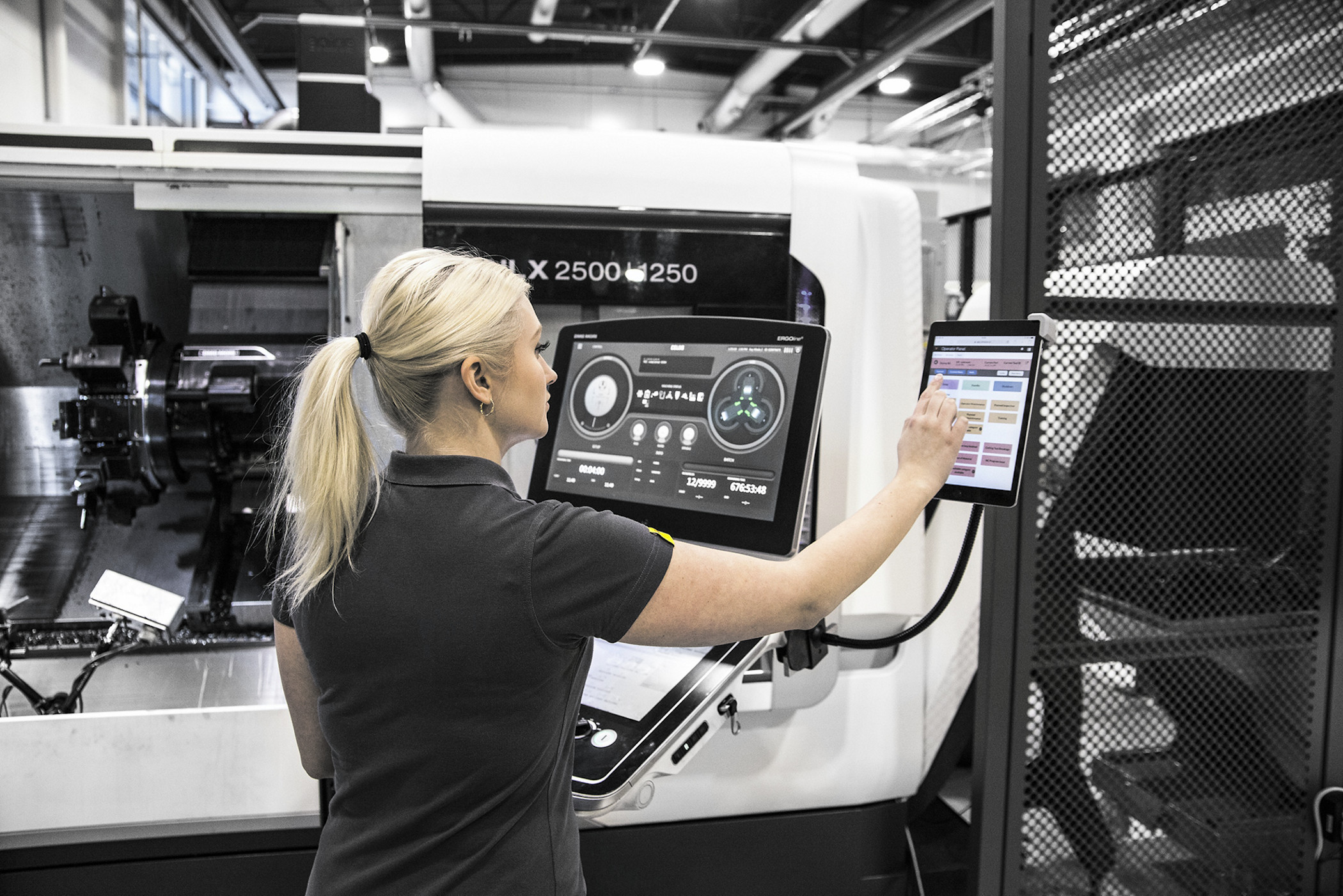Software platform delivers return on investment for manufacturers within weeks
 The Industrial Internet of Things (IIoT) is accelerating the pace of change around connecting machines. Yet, fewer than 30% of manufacturers have extensively adopted Industry 4.0 technologies according to a new report.
The Industrial Internet of Things (IIoT) is accelerating the pace of change around connecting machines. Yet, fewer than 30% of manufacturers have extensively adopted Industry 4.0 technologies according to a new report.
Manufacturers need to start listening to what machines are saying by connecting up their machine shops, said Bijal Patel, Senior Digital Machining Specialist at global leader in metal cutting Sandvik Coromant.
The IIoT has perhaps impacted manufacturing more than any other industry. The IIoT market is set to grow from $68.8 billion in 2019 to $98.2 billion by 2024 yet, on the other hand, a recent Industry 4.0 & Smart Manufacturing Adoption Report by IoT Analytics suggests that Industry 4.0 technology uptake is still low among manufacturers.
The transformation from linear plant setups into dynamic and interconnected systems is one of the greatest challenges of our times for machine shops. Some are unsure as to how Industry 4.0 fits into their established way of doing things. Many perceive the adding of Industry 4.0 to existing production setups are being expensive — when it actually needn’t be. And other manufacturers see no reason to upgrade their existing tooling set-up and processes.
Any given business will be at a different stage of their journey towards embracing digitalization with any specific view as to how this should be achieved.
But they need to make up their minds, as the COVID-19 continues to spell an unpredictable future for industry. In its recent COVID-19: Briefing note, analyst McKinsey & Company describes the upcoming climate for manufacturers as the “next normal” where manufacturers can expect unpredictable and lasting shifts in customer markets.
 The report says that resilience will be needed if manufacturers are to navigate an economically and socially viable path. Elsewhere, Pricewaterhouse Coopers’ (PwC) own COVID-19: What it means for industrial manufacturing report recommends that companies must expand into new industries, and take advantage of fresh revenue streams, either because they are forced to by defunct markets or because they simply spot an opportunity.
The report says that resilience will be needed if manufacturers are to navigate an economically and socially viable path. Elsewhere, Pricewaterhouse Coopers’ (PwC) own COVID-19: What it means for industrial manufacturing report recommends that companies must expand into new industries, and take advantage of fresh revenue streams, either because they are forced to by defunct markets or because they simply spot an opportunity.
Manufacturers must get on board now with these concepts to adapt existing processes, and to do so quickly and cost-effectively — but, how?
More data, more problems?
Fortunately, one solution involves a powerful — yet simple — approach. Sandvik Coromant first launched its latest CoroPlus® MachiningInsights platform, an expansion of the company’s CoroPlus suite of connectivity software, in 2018 at the International Manufacturing Technology Show (IMTS) in Chicago, US. The platform is designed to give manufacturers greater visibility of CNC machine tools and machining processes, and to provide the tools needed to analyze, identify, and eliminate common sources of downtime and inefficiency.
Such a platform should prove useful as both Industry 4.0 and the Industrial Internet of Things (IIoT) accelerate the pace of change around machine connectivity. The answer lies in the volume of data to be managed. Any CNC with an Ethernet port can send information to MachiningInsights at higher volume than most CNC shops currently collect, for producing manufacturing data analytics to improve workshop efficiency and overall equipment effectiveness (OEE).
As for different manufacturers at different stages of their IIoT journey, machines that are less than 10 to 15-years-old will probably already be connectible to the network, and there are adapters for older machines to make them network capable. MTConnect, the manufacturing technical standard for retrieving process information from numerically controlled machine tools, is the established protocol used to communicate with Sandvik Coromant’s CNC software. It can also connect to other types of manufacturing equipment using standard communication protocols.
The safety question
One aspect of MTConnect that may raise eyebrows is that it only allows one-way communication. Some plant managers may regard the use of uni-directional, instead of bi-directional, communication as a drawback. Sandvik Coromant recognizes the argument, but developers of MTConnect had some excellent reasons to make it uni-directional.
From my own experiences of working in machine shops for many years, I still question how we can remotely control equipment that has human beings around it, while also guaranteeing their safety. Uni-directional communication puts control firmly in the user’s hand, for a simpler and safer approach.
Another question of safety is that two-way communications make a machine tool more difficult to manage from a cybersecurity point of view. Many of today’s CNCs run Microsoft Windows, which historically has been known to present vulnerabilities. By limiting the flow of data to uni-directional communication, we help close that door and make certain that a shop’s million-dollar multitasking machine will not be held for ransom!
Better access
Since its launch, MachiningInsights has proven its value on the shop floor. Before implementing MachiningInsights, a shop supervisor would spend each morning entering performance indicators from the previous day’s production into a spreadsheet, then distribute that information to management and on to people on the production floor.
If the operator adjusts a feedrate override, or a tool breaks, or the machine has been idle for a given number of minutes, MachiningInsights provides users with the ability to configure e-mail or SMS alerts based on any one of several dozen conditions or events, which are just a few of the everyday situations that contribute to machine downtime.
The platform comes with a set of preconfigured reports and dashboards to get customers up and running quickly, who are free to modify them or to build their own from scratch. Users can log on to their MachiningInsights website and view whatever they have been allowed access to by the shop’s administrator. Anyone who wants to see this data can open real-time dashboards or reports, and have visibility of what is currently happening, rather than what happened yesterday. The supervisor now has more time to act on information, instead of simply collecting it for historical purposes.
If manufacturers already have an Enterprise Resource Planning (ERP) system in place, and want to avoid installing another software package, Sandvik Coromant has a standard application programming interface (API) that tech-savvy shops can use to connect MachiningInsights to other software. It is secure, easy to set up, and can be done with or without Sandvik Coromant support.
As with all Software as a Service (SaaS) products, there is a negligible subscription fee based on the platform level and the number of machines to monitor — a small price to pay for the enhanced visibility, ease-of-use, and significantly greater opportunities for continuous improvement. ROI is typically attained in weeks or months — not years.
New ways to automate
Also in its ‘COVID-19: What it means for industrial manufacturing report,’ PwC recommends that manufacturers should: “Expect a learning curve as companies devise new ways of working that involve more remote workers and automation on the factory floors.”
For workshops that are running unattended or lightly attended, MachiningInsights can monitor spindle and servo loads, macro variables and operational status, and if the machine is equipped with the right sensors, temperature, power, and more.
MachiningInsights is a subscription-based SaaS installed remotely by Sandvik Coromant. Once customers have identified the machines they wish to monitor, they can give Sandvik Coromant access to their server via TeamViewer or similar remote desktop software to install the service.
The IIoT will continue its rapid growth and make countless productivity, profit and maintenance advantages available to machine shops that are willing to overcome their reluctance to embrace Industry 4.0. With the use of powerful-yet-simple software and by partnering with a trusted tooling specialist like Sandvik Coromant, manufacturers can go digital on their own terms — and be within the 30% of manufacturers that are prepared for an unpredictable future.
Contact Details
Related Glossary Terms
- computer numerical control ( CNC)
computer numerical control ( CNC)
Microprocessor-based controller dedicated to a machine tool that permits the creation or modification of parts. Programmed numerical control activates the machine’s servos and spindle drives and controls the various machining operations. See DNC, direct numerical control; NC, numerical control.

